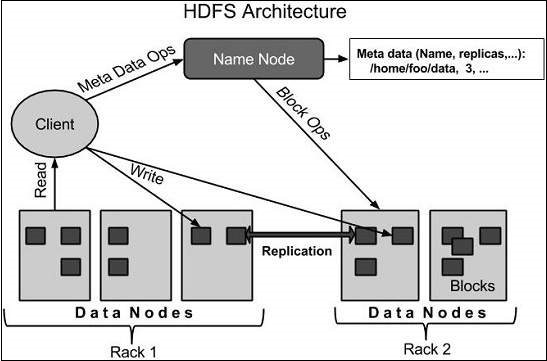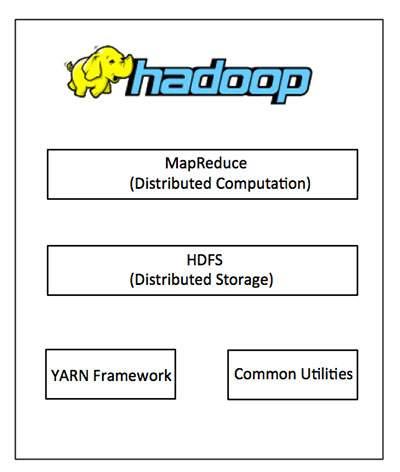Hadoop is an open-source framework that allows to store and process big
data in a distributed environment across clusters of computers using
simple programming models. It is designed to scale up from single
servers to thousands of machines, each offering local computation and
storage.
Hadoop
is an Apache open source framework written in java that allows
distributed processing of large datasets across clusters of computers
using simple programming models. A Hadoop frame-worked application
works in an environment that provides distributed storage and
computation across clusters of computers. Hadoop is designed to scale
up from single server to thousands of machines, each offering local
computation and storage.
Hadoop
Architecture
Hadoop
framework includes following four modules:
Hadoop
Common: These are Java libraries and utilities required by other
Hadoop modules. These libraries provides filesystem and OS level
abstractions and contains the necessary Java files and scripts
required to start Hadoop.
Hadoop
YARN: This is a framework for job scheduling and cluster resource
management.
Hadoop
Distributed File System (HDFS™): A distributed file system that
provides high-throughput access to application data.
Hadoop
MapReduce: This is YARN-based system for parallel processing of
large data sets.
We
can use following diagram to depict these four components available
in Hadoop framework.
Since
2012, the term "Hadoop" often refers not just to the base
modules mentioned above but also to the collection of additional
software packages that can be installed on top of or alongside
Hadoop, such as Apache Pig, Apache Hive, Apache HBase, Apache Spark
etc.
MapReduce
Hadoop
MapReduce is a software framework for easily writing applications
which process big amounts of data in-parallel on large clusters
(thousands of nodes) of commodity hardware in a reliable,
fault-tolerant manner.
The
term MapReduce actually refers to the following two different tasks
that Hadoop programs perform:
The
Map Task: This is the first task, which takes input data and
converts it into a set of data, where individual elements are broken
down into tuples (key/value pairs).
The
Reduce Task: This task takes the output from a map task as input and
combines those data tuples into a smaller set of tuples. The reduce
task is always performed after the map task.
Typically
both the input and the output are stored in a file-system. The
framework takes care of scheduling tasks, monitoring them and
re-executes the failed tasks.
The
MapReduce framework consists of a single master JobTracker and one
slave TaskTracker per cluster-node. The master is responsible for
resource management, tracking resource consumption/availability and
scheduling the jobs component tasks on the slaves, monitoring them
and re-executing the failed tasks. The slaves TaskTracker execute the
tasks as directed by the master and provide task-status information
to the master periodically.
The
JobTracker is a single point of failure for the Hadoop MapReduce
service which means if JobTracker goes down, all running jobs are
halted.
Hadoop
Distributed File System
Hadoop
can work directly with any mountable distributed file system such as
Local FS, HFTP FS, S3 FS, and others, but the most common file system
used by Hadoop is the Hadoop Distributed File System (HDFS).
The
Hadoop Distributed File System (HDFS) is based on the Google File
System (GFS) and provides a distributed file system that is designed
to run on large clusters (thousands of computers) of small computer
machines in a reliable, fault-tolerant manner.
HDFS
uses a master/slave architecture where master consists of a single
NameNode that manages the file system metadata and one or more slave
DataNodes that store the actual data.
A
file in an HDFS namespace is split into several blocks and those
blocks are stored in a set of DataNodes. The NameNode determines the
mapping of blocks to the DataNodes. The DataNodes takes care of read
and write operation with the file system. They also take care of
block creation, deletion and replication based on instruction given
by NameNode.
HDFS
provides a shell like any other file system and a list of commands
are available to interact with the file system. These shell commands
will be covered in a separate chapter along with appropriate
examples.
How
Does Hadoop Work?
Stage
1
A
user/application can submit a job to the Hadoop (a hadoop job client)
for required process by specifying the following items:
The
location of the input and output files in the distributed file
system.
The
java classes in the form of jar file containing the implementation
of map and reduce functions.
The
job configuration by setting different parameters specific to the
job.
Stage
2
The
Hadoop job client then submits the job (jar/executable etc) and
configuration to the JobTracker which then assumes the responsibility
of distributing the software/configuration to the slaves, scheduling
tasks and monitoring them, providing status and diagnostic
information to the job-client.
Stage
3
The
TaskTrackers on different nodes execute the task as per MapReduce
implementation and output of the reduce function is stored into the
output files on the file system.
Advantages
of Hadoop
Hadoop
framework allows the user to quickly write and test distributed
systems. It is efficient, and it automatic distributes the data and
work across the machines and in turn, utilizes the underlying
parallelism of the CPU cores.
Hadoop
does not rely on hardware to provide fault-tolerance and high
availability (FTHA), rather Hadoop library itself has been designed
to detect and handle failures at the application layer.
Servers
can be added or removed from the cluster dynamically and Hadoop
continues to operate without interruption.
Another
big advantage of Hadoop is that apart from being open source, it is
compatible on all the platforms since it is Java based.




